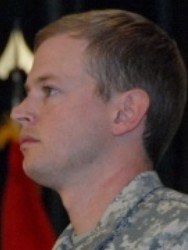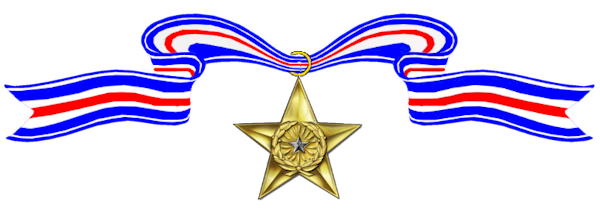The President of the United States of America, authorized by Act of Congress July 9, 1918 (amended by an act of July 25, 1963), takes pleasure in presenting the Silver Star to Staff Sergeant Justin A. Schafer, United States Army, for exceptional heroism while serving with Operational Detachment Alpha 3336 (ODA-3336), 3d Battalion, 3d Special Forces Group (Airborne), on 4 May 2010 in support of Operation ENDURING FREEDOM in Afghanistan. His outstanding dedication to duty during combat operations in Afghanistan contributed to the overwhelming success of the Command’s mission. He placed his own safety at risk to treat several Commandos and to save the life of one of his Afghan comrades. He expertly performed the role of warrior and medic in the face of grave danger. His actions are in keeping with the finest traditions of military heroism and reflect distinct credit upon himself, the Combined Joint Special Operations Task Force – Afghanistan, the Combined Forces Special Operations Component Command – Afghanistan, and the United States Army.
NARRATIVE TO ACCOMPANY AWARD:
Staff Sergeant Justin A. Schafer gallantly distinguished himself through exceptionally valorous conduct in the face of the enemy of Afghanistan as the Junior Medical Sergeant for Operational Detachment Alpha 3336 (ODA-3336) with Special Operations Task Force – East with combined Joint Special Operations Task Force – Afghanistan in support of Operation ENDURING FREEDOM. On 4 May 2010, while combat advising the 3d Company, 6th Command Kandak, Sergeant Schafer played a vital role in mission accomplishment due to his professionalism, technical and tactical proficiency and unsurpassed courage. The Commandos and ODA 3336 conducted disruption operations in Hendor Village, Mehtar Lam District, Laghman Province, Afghanistan. Their mission set conditions for Coalition Forces to clear enemy safe havens in adjacent valleys. The insurgents had complete freedom of movement from which they planned and coordinated attacks against the Afghan National Security Forces and Coalition Forces throughout the region. At 0330 hours, the 3d Company, 6th Command Kandak and ODA 3336 conducted an air assault onto Objective MUDSLIKE in Hendor Village to clear a series of compounds suspected of housing insurgent leaders. Upon infiltration, the HA-64 Air Weapons Team (AWT) and AC-130 gunship identified five armed personnel assembling at the southern end of the village. Simultaneously, AWT identified 40 enemy personnel south of the village, maneuvering on friendly forces. The aircraft monitored insurgents emplacing several improvised explosive devices and establishing multiple firing positions. The aircraft monitored insurgents emplacing several improvised explosive devices and establishing multiple fighting positions. Knowing the enemy’s preparations, the assault force made the decision to continue forward, close the distance with the enemy, and push on with the mission. Sergeant Schafer continued forward with Supporting Effort 1, fully knowing that the enemies of Afghanistan lay in wait somewhere up ahead. As Sergeant Schafer and SE2 made entry into a compound on the eastern trace of the village, they began receiving a high volume of enemy fire. Insurgents outnumbered the assault force by two-to-one and owned the surrounding high ground, which was littered with concealed caves, spider holes and defensive fighting positions. Their concealed positions provided unobstructed 360 degree fields of fire, enabling them to accurately and heavily engage the assault force for over 10 hours with machinegun and sniper fire. During the fighting, enemy heavy machinegun fire kept the Maine Effort pinned down, as all elements were under accurate volleys of enemy fire from 350 degrees. After several hours of fighting, a Commando moving across an open area received a gunshot wound to the right shoulder. Sergeant Schafer moved to the exposed area with no regard for his personal safety to reach the Commando. Despite being under heavy machinegun fire, Sergeant Schafer maintained a calm state of mind and performed a thorough medical assessment. As Sergeant Schafer brought the bleeding under control, his position came under another barrage of heavy PKM machinegun fire, striking Sergeant Schafer twice with rounds lodging in his aid bag and throwing him against a compound wall. Unfazed and in complete control, Sergeant Schafer maintained his situational awareness and took the initiative, instructing his element to move into a nearby compound and establish a Casualty Collection Point (CCP). Sergeant Schafer moved the casualty to the CCP and then immediately returned to the enemy kill zone, still under accurate machinegun fire, where another Commando was in critical condition after being shot in the face. Sergeant Schafer, without hesitation, made his way to the Commando in the direct line of enemy fire, controlled the excessive bleeding coming from the Commando’s face before safely moving him to the CCP. Constantly engaged by enemy fire, Sergeant Schafer continued treating the casualties in a controlled manner, instilling confidence in the rest of his element to continue with the fight. After preparing the two casualties for movement to the initial Helicopter Landing Zone for Medical Evacuation, Sergeant Schafer continued critical medical treatment, all the while moving under a heavy barrage of enemy fire. The litter team carrying the casualty was consumed by relentless, accurate, heavy machinegun fire, causing them to abandon the casualty and take cover. Sergeant Schafer placed himself in front of the ambulatory casualty to protect him from incoming fire and safely moved him out of the area. Realizing the gravity of the situation, Sergeant Schafer radioed to the senior medic that he was on his way back to retrieve the litter casualty. After assembling some Commandos and leading the charge back down the alleyway, Sergeant Schafer reached the pinned down element only to find the Commandos had taken cover behind a wall. Sergeant Schafer kept moving under heavy machinegun and sniper fire and made it to the casualty. Continuing to move through the kill zone and over remnants of dilapidated stone structures, Sergeant Schafer was forced to take cover due to the devastating fire of enemy machineguns that cut him off from the rest of the aid and litter team. After 30 minutes of being cut off alone and with unwavering enemy fire pinning him down, the detachment senior engineer initiated a large controlled detonation in Sergeant Schafer’s general vicinity. The explosion resulted in a large dust cloud, which gave Sergeant Schafer a small window of opportunity to use as concealment to reconnoiter a route back to the CCP. Sergeant Schafer led the way for the aid and litter team across open terrain for more than 50 meters. Upon leaving the concealment of the dust cloud, enemy fighters commenced another attack on the aid and litter team. Still separated from the main force, Sergeant Schafer traversed numerous danger areas, all the while covering the casualty through the open areas. Sergeant Schafer took up a position to cover the medical evacuation on the ground and maintained a constant rate of fire until the aircraft made a safe exit. Sergeant Schafer linked up with his element, and continued to engage the enemy until exfiltration was complete. Sergeant Schafer’s selfless actions under extreme duress saved the lives of several United States Special Forces Soldiers and Afghanistan Commandos. His gallantry and perseverance under extreme circumstances played a vital role in the destruction of three enemy fighting positions, the killing of one Taliban commander and three Taliban sub-commanders strong-pointed in reinforced defensive positions. His actions are in keeping with the finest traditions of military heroism and reflect distinct credit upon himself, the Combined Joint Special Operations Task Force Ð Afghanistan, the Combined Forces Special Operations Component Command Ð Afghanistan and the United States Army.
Justin
A.
Schafer

Home:
Fayetteville
,
North Carolina
Awards Received
-

Silver Star
-
Silver Star
Service:
United States ArmyRank:
Staff SergeantBatallion:
3d BattalionRegiment:
3d Special Forces Group (Airborne)Action Date:
May 4, 2010

